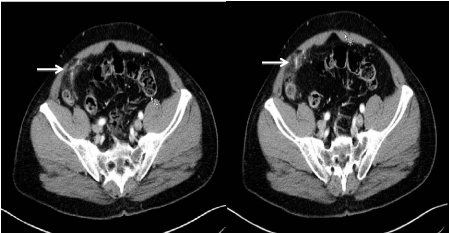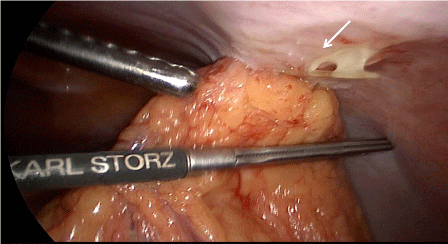Case Report
Appendiceal Perforation Secondary to Fish Bone Perforation
Rosales-Velderrain A, Darwiche N, Szomstein S, LoMenzo E and Rosenthal RJ*
Department of General Surgery, Bariatric and Metabolic Institute, USA
*Corresponding author: Raul J. Rosenthal, Department of General Surgery, Bariatric and Metabolic Institute, Cleveland Clinic Florida, USA
Published: 09 Sep, 2016
Cite this article as: Rosales-Velderrain A, Darwiche N,
Szomstein S, LoMenzo E, Rosenthal RJ. Appendiceal Perforation Secondary to Fish Bone Perforation. Clin Surg. 2016; 1: 1107.
Abstract
Introduction: Ingestion of foreign body occurs commonly, though the majority passes through the gastrointestinal tract uneventfully, rarely causing a perforation. We report a rare case of appendiceal perforation secondary to a fish bone (FB).
Material and Methods: A 46-year-old male presented with one-week history of Right Lower Quadrant (RLQ) pain that radiated to the ipsilateral thigh and genital. His vital signs were within normal limits. On physical examination the abdomen was mildly distended with localized RLQ pain, without guarding or peritoneal signs. The white blood count was 9.21 K/UL. A computedtomography revealed inflammatory vascular changes in the anteromedial aspect of the cecum, leading into the base of the appendix. It was thought that this represented the appendicular artery, supporting the diagnosis of vasculitis and/or early appendicitis, though the appendix was not dilated. The patient was admitted for observation, made NPO, started on intravenous fluids, and broad-spectrum antibiotics.
Results and Discussion: Because of the persistence of pain, the decision was made to take him to the operating room for a laparoscopic appendectomy. Once pneumoperitoneum was obtained, the appendix was taken down from the anterior abdominal wall, where a FB was protruding and had caused the appendix to adhere. The extra luminal FB was removed, and a standard laparoscopic appendectomy was performed.
Conclusion: FB ingestion is uncommon, and rarely causes perforations. Nonetheless, in cases of atypical presentation, this should be considered as a potential cause of abdominal pain and appendix perforation. Appendix perforation secondary to FB can be managed with a laparoscopic approach.
Keywords: Appendiceal; Perforation; Fish bone; Foreign body
Introduction
Ingesting a Foreign Body (FB) while eating is relatively common, most passing through the gastrointestinal tract uneventfully, this with a low probability of perforating the gastrointestinal tract [1]. The bowel injury typically occurs in areas of bowel angulation, being the common the terminal ileum, a hernia sac or Meckel’s diverticulum [2 and 3]. Conversely, perforation of the appendix due to an ingested fish bone is a rare event, and to the authors’ knowledge this was last reported in 1967 [4]. Diagnosis of this condition is problematic as a definitive identification is difficult even with the assistance of imaging techniques, such as computer tomography. This complicates preoperative diagnoses, often pointing toward acute appendicitis, as the inflammation of the appendix is frequently secondary to the presence of a fish bone [5 and 6]. We report an appendix perforation by an ingested fish bone found after imaging suspicion of vasculitis with persistent Right Lower Quadrant (RLQ) abdominal pain, patient was scheduled for a laparoscopic appendectomy.
Case Presentation
A 46 year-old male with a body mass index (BMI) of 31.89 kg/m2, with history of nephrolithiasis and without prior surgeries presented to our institution with right lower quadrant pain. Initial symptoms started one-week prior to admission, the pain started in the right lower quadrant and radiated to the ipsilateral thigh, scrotum and penis. The patient denied having any other symptoms. His vital signs upon admission were unremarkable. On physical examination his abdomen was soft, mildly distended with localized RLQ tenderness, positive Rovsing’s sign, and negative obturator and psoas sign, without evidence of masses, organomegaly, guarding, or peritoneal signs. Complete blood count revealed a normal white blood count of 9.21 K/UL. Basic metabolic panel and liver function test were normal. An abdominopelvic computed tomography scan showed a mild right basilar bronchiectasis with fibrosis in the medial basal aspect of the right lower lobe, fatty infiltration of the liver, and inflammatory changes were noted along the vascular structure that travels adjacent to the anteromedial aspect of the cecum, leading into the base of the appendix. It was noted that this represented the appendicular artery, supporting for vasculitis and/or early appendicitis, though the appendix was not dilated and measured 6.7 mm in caliber (Figure 1). Given these findings the patient was admitted to the surgical floor for observation, made NPO, and was started on intravenous fluids and broad-spectrum antibiotics. In spite of normal laboratory results, the patient did not improve; thus the decision was made to take him to the operating room for a laparoscopic appendectomy.
Once the abdomen was accessed and the remaining ports were
placed, the appendix was adhered to the abdominal wall and covered
with omentum, where the fish bone was protruding (Figure 2). Using
a bowel grasper, this was removed, followed by an appendectomy.
His operative course was uneventful; he was discharged home on
postoperative Day 1. The pathology report was consistent with
appendiceal mild follicular lymph hyperplasia. He had a normal
postoperative course.
Figure 1
Figure 1
Abdominopelvic computed tomography that demonstrates a hyperdense linear structure, corresponding to the fish bone (white arrow).
Figure 2
Figure 2
Appendix covered with omentum and attached to the abdominal wall, fish bone (white arrow) protruding through the appendix.
Discussion
The diagnosis of a perforation in the gastrointestinal tract often
proves to be complicated. As the event often presents itself with
secondary appendicitis, it is not until the surgery is underway that
the presence of a foreign body is observed [5 and 6]. Moreover, not being
able to rely on imaging, together with the presence of a large number
of different symptoms can lead to an incorrect diagnosis, as it was in
this case. This is the first reported case of a puncture of the appendix
by a fishbone in almost fifty years [4]. Sharp objects such as foreign
bodies will most likely puncture sites with serious angulations, such
as the terminal ileum, ileocecal junction and the flexures of the colon
[3]. Given the low probability of a fish bone perforation and the even
lower probability of this perforating the appendix.
Computed tomography was a low sensitivity in detecting
fish bones; usually the perforation can appear as localized fatty
infiltration, segmental wall thickening, localized pneumoperitoneum
or associated intestinal obstruction [7 and 8]. The only way to get to a
definitive diagnosis would be by identifying the calcified bone, and
that would depend on the degree of calcification, which varies with
the species of fish [8 and 9]. Our patient’s computed tomography revealed
a linear hyperdense structure that the radiologist believed to be the
appendiceal artery; however, in retrospect this was a calcified fish
bone. In contrast with metallic foreign bodies, which can easily be seen
in an X-ray, non metallic foreign bodies are much less memorable,
and imaging can be of no assistance [3].
The most suitable course of action in these situations has been
focused on in the literature. Overall, there is insufficient evidence
provided in the literature to recommend the use of non-operative
management in foreign body induced perforations. Laparoscopic
approaches to the presence of foreign bodies have been reported
on several occasions and have proven to be very effective [10]. This
approach allows for proper inspection of the peritoneal cavity, while
protecting the surgeon from injury and in most cases demonstrating
uneventful postoperative recovery.
Conclusion
Foreign bodies rarely cause intestinal perforations; even rarer is an appendix perforation. Diagnostic laparoscopy remains the first choice in cases of RLQ pain of uncertain diagnosis.
References
- Selivanov V, Sheldon GF, Cello JP, Crass RA. Management of foreign body ingestion. Annals of Surgery. 1984; 199: 187-191.
- Goh BK, Chow PK, Quah HM, Ong HS, Eu KW, Ooi LL, et al. Perforation of the gastrointestinal tract secondary to ingestion of foreign bodies. World J Surg. 2006; 30: 372–377.
- Ginzburg L, Beller AJ. The clinical manifestations of non-metallic perforating intestinal foreign bodies. Ann Surg. 1927; 86: 928-939.
- Ball JR. Complete perforation of appendix by a fish bone. Br J Clin Pract. 1967; 21: 99.
- Beecher SM, O’Leary DP, McLaughlin R. Diagnostic dilemma due to fish bone ingestion: Case report & literature review. Int J Surg Case Rep. 2015; 13: 112-115.
- Saunders D, Jones M, Kaushik M, Thomas WM. Fish bone perforation of the terminal ileum presenting as acute appendicitis. 2014.
- Chandrasinghe PC, Pathirana CK. Laparoscopically detected and nonsurgically managed ileal perforation by an ingested fish bone: a case report. Journal of Medical Case Reports. 2015; 9: 43.
- Coulier B, Tancredi MH, Ramboux A. Spiral CT and multidetector-row CT diagnosis of perforation of the small intestine caused by ingested foreign bodies. Eur Radiol. 2004; 14: 1918–1925.
- SEll SR, Sprigg A. The radio-opacity of fishbones - species variation. Clin Radiol. 1991; 44: 104–107.
- Lunsford KE, Sudan R. Small bowel perforation by a clinically unsuspected fish bone: laparoscopic treatment and review of literature. J Gastrointest Surg. 2012; 16: 218–222.


